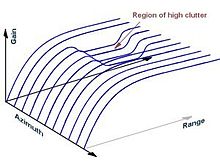Sensitivity Time Control
The sensitivity time control ( STC ; German " sensitivity time control is"), a circuit in a radar device which the, receiver dynamic influences. It is a time-dependent gain control that causes dynamic range compression . Near-end echo attenuation is also often used . Some speed camera manufacturers also use the term Gain Time Control (GTC) for this function in their device documentation .
Very high demands are made on a radar receiver. It must be able to process extremely small signals and at the same time must not be overdriven by very large signals . In a radar device, echo signals with very low reception powers are usually caused by objects that are very far away. At the same time, however, very far away means that the transit time is relatively long compared to the echo signals from the close range of the radar.
In the case of an amplifier with STC function, the gain is continuously increased over the course of the reception time. The gain factor is therefore dependent on the time and thus also on the distance R. Ideally, the gain factor V is proportional to R 4 . In practice, this curve is often approximated by the exponential function that arises when charging a capacitor . In contrast to a signal limitation, a difference (albeit a significantly reduced one) between the differently sized input signals must remain recognizable even after compression.
Since the fixed target echoes predominate in the close range, which usually also have much larger geometric dimensions than aircraft, a control range of up to 30 dB is used. The size of the fixed target echoes, which vary depending on the current angle of the antenna, dictates the reference size of the STC curve. With the very long transmission pulses from radar devices that work with the pulse compression method , it must be ensured that the change in gain does not lead to changes in the pulse shape. That is why modern radar receivers measure the level of the fixed target echoes for each range cell and then set the STC attenuation depending on the azimuth and distance. In most cases, however, only one of several standard curves with different slopes is used.
A manually controlled STC function is used in navigation radar devices for ships and boats to suppress sea clutter . Since this only reduces the gain of the radar receiver, smaller and weaker signals are also suppressed.

